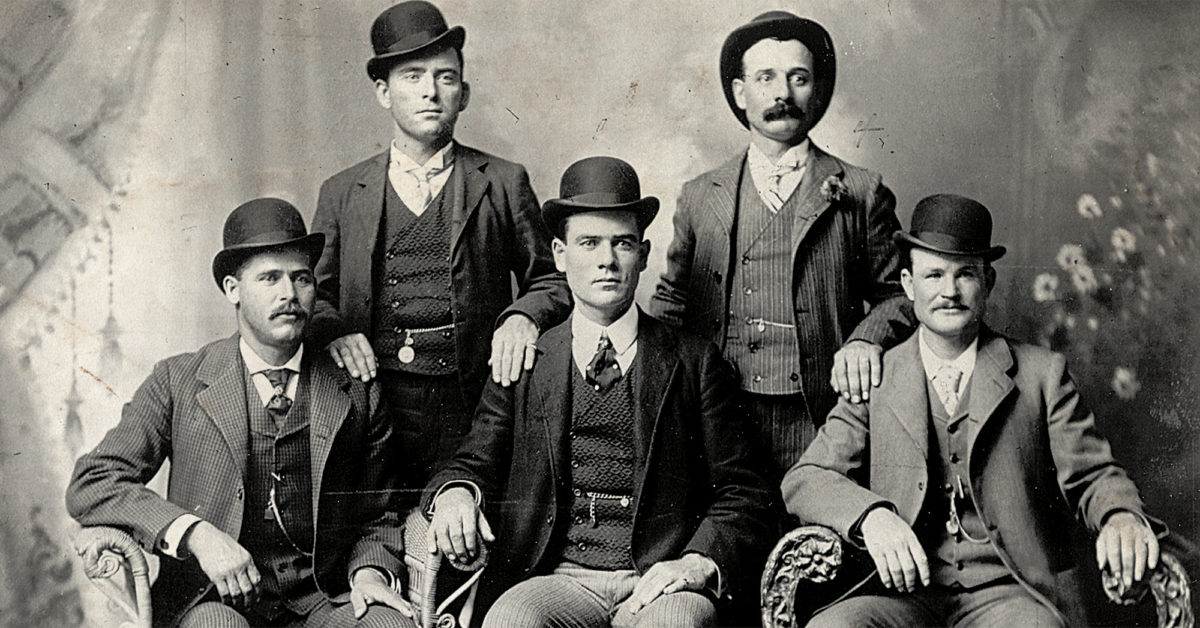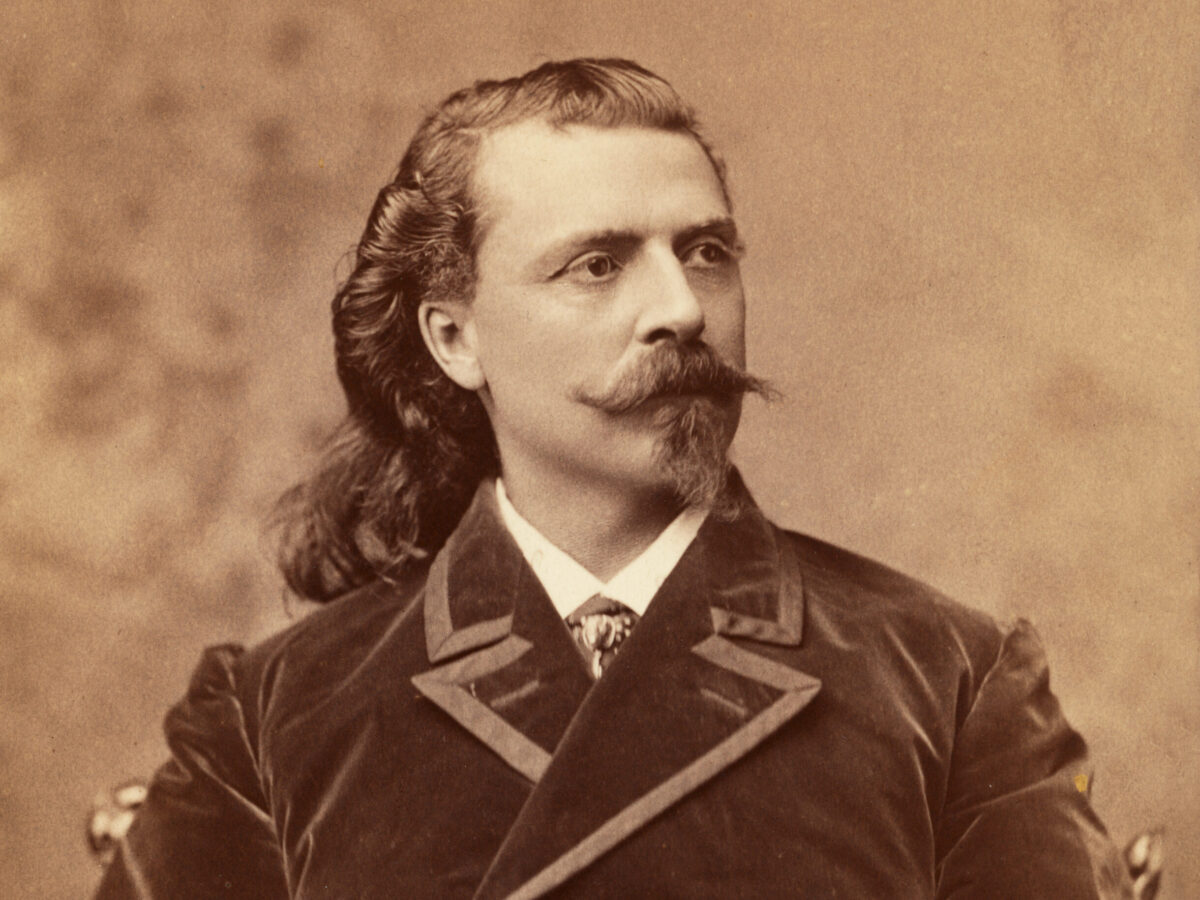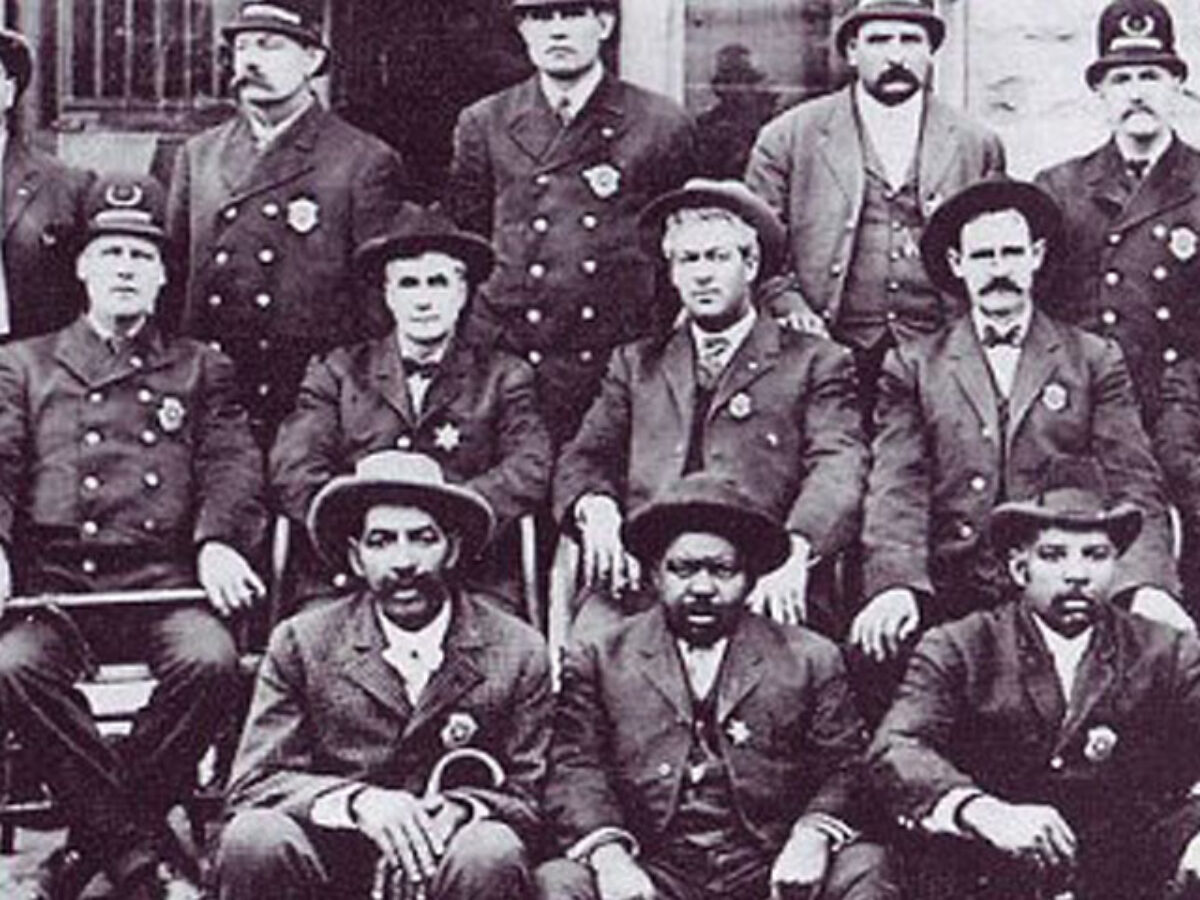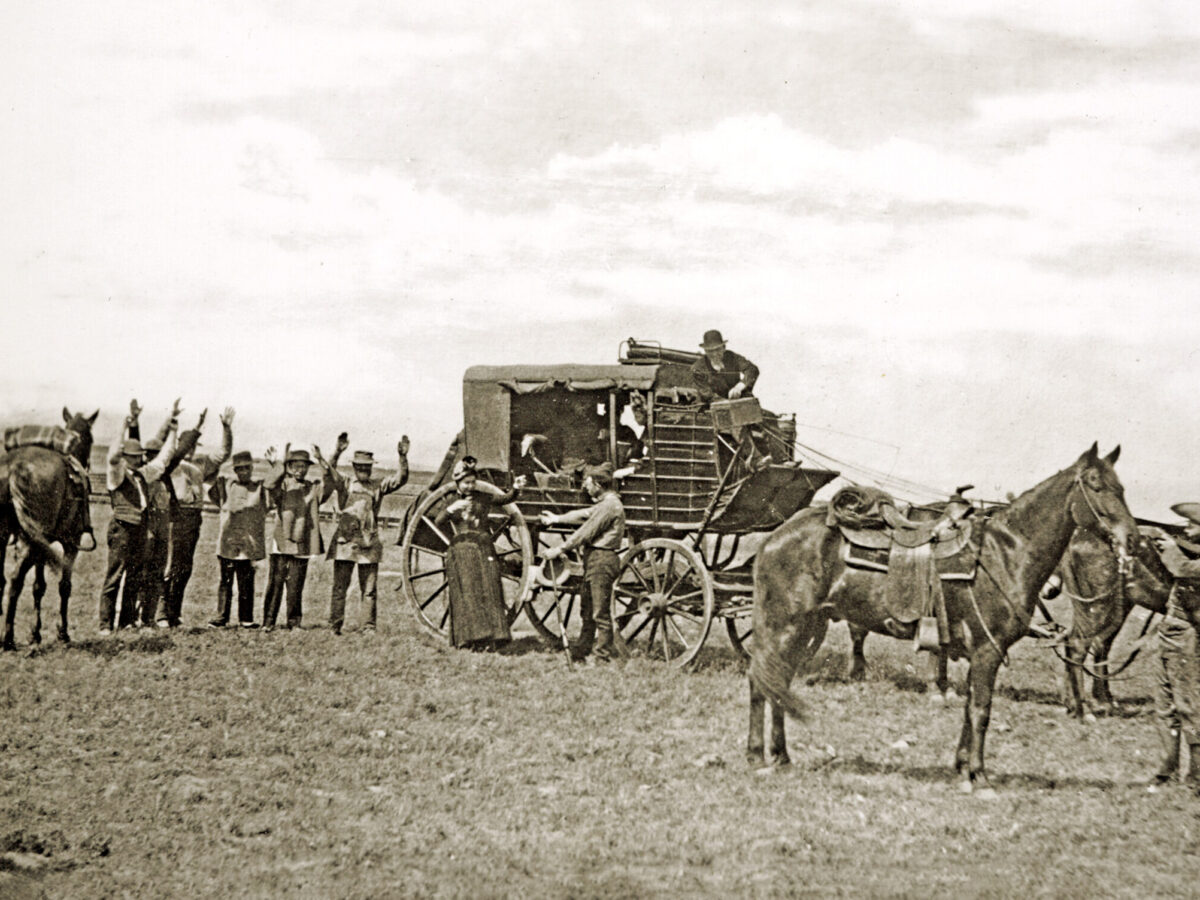At the end of the movie Butch Cassidy and the Sundance Kid, Paul Newman and Robert Redford reload their six-shooters and exchange a final round of wisecracks, then dash valiantly into a plaza rimmed with Bolivian soldiers. The movie, a box-office smash in 1969 and a late-night television chestnut today, closes with the wounded outlaws facing almost certain doom. The frame freezes before the antiheroes fall, however, leaving open the barest possibility of their survival.
The movie is based on a true story, which began shortly after the Civil War. The outlaw known as Butch Cassidy, born Robert LeRoy Parker on April 13, 1866, was the eldest of 13 children in a Mormon family in Utah. His admiration for a young cowboy named Mike Cassidy and a stint as a butcher inspired his nom de crime. A stretch in a Wyoming prison for the theft of a $5 horse impelled him toward a life on the run.
The Sundance Kid, born Harry Alonzo Longabaugh in the spring of 1867, was the youngest of five children in a Baptist family in Pennsylvania. After heading west at the age of 15, he ranched with relatives in Colorado, then knocked around the U.S. and Canadian Rockies, working as a drover and broncobuster. He earned his nickname by serving 18 months in jail at Sundance, Wyo., for stealing a horse.
Sundance’s companion in the movie was Etta Place. His companion in real life was an enigma. Although she has been described as a prostitute, a teacher, or both, no one knows her true origin or fate. Even her name is a mystery. The Pinkerton Detective Agency called her Etta on its wanted posters, but she called herself Ethel, which may or may not have been her real name. Traveling as Sundance’s wife, she shared the alias Place (his mother’s maiden name).
GET HISTORY’S GREATEST TALES—RIGHT IN YOUR INBOX
Subscribe to our HistoryNet Now! newsletter for the best of the past, delivered every Monday and Thursday.
Hole-in-the-Wall Gang
Butch and Sundance belonged to a loose-knit gang that included the likes of Elzy Lay, Matt Warner, Harvey ‘Kid Curry’ Logan, Ben ‘Tall Texan’ Kilpatrick and Will Carver. Dubbed the Train Robbers’ Syndicate, the Hole-in-the-Wall Gang and the Wild Bunch, the band held up trains and banks and stole mine payrolls in the Rocky Mountain West, making off with a total of $200,000 (the equivalent of $2.5 million today) between 1889 and the early 1900s.
With $1,000 rewards on their heads and the Pinkertons on their tails, Butch and Sundance fled to South America with Ethel in 1901. The movie takes them directly from New York City to Bolivia, but their initial destination was actually Argentina. After steaming into Buenos Aires on the British ship Herminius in March and taking the train to Patagonia in June, they settled in the Chubut Territory, a frontier zone in southern Argentina sparsely populated by immigrants, pioneers and Indians. Although most of the immigrants were Welsh or Chilean, several North Americans had journeyed to the same corner of the world, looking for open ranges. The bandits’ nearest neighbor, for example, was John Commodore Perry, who had been the first sheriff of Crockett County, Texas. Butch and Sundance also traded and socialized with another Texan, Jarred Jones, who lived a two days’ ride north, near Bariloche.
Calling themselves James ‘Santiago’ Ryan and Mr. and Mrs. Harry ‘Enrique’ Place, the Wild Bunch exiles peacefully homesteaded a ranch in the Cholila Valley, raising sheep, cattle and horses. All three got on well with their neighbors, and if anyone came to know about Butch and Sundance’s shady past, it never interfered with those good relations. So highly were they regarded that when Territorial Governor Julio Lezana visited the valley in early 1904, he spent the night in their home, a well-kept four-room log cabin on the east bank of the Blanco River. During the welcoming festivities, Sundance played sambas on his guitar and Lezana danced with Ethel.
On their trail
Meanwhile, in March 1903, the Pinkertons had sent agent Frank Dimaio to Buenos Aires, after receiving a tip that Butch and Sundance were living in Argentina. Dimaio traced their whereabouts, then cabled his superiors, saying the rainy season prevented him from going to Cholila. Before leaving Buenos Aires, he supplied the police with translated versions of the bandits’ wanted posters.
On February 14, 1905, two English-speaking bandits held up the Banco de Tarapacá y Argentino in Río Gallegos, 700 miles south of Cholila, near the Strait of Magellan. Escaping with a sum that would be worth at least $100,000 today, the pair vanished north across the bleak Patagonian steppes. Although Butch and Sundance were never positively identified as the culprits (whose descriptions didn’t fit them as well as the modus operandi did), they were the prime suspects.
Responding to a directive from the Buenos Aires police chief, Governor Lezana issued an order for Butch and Sundance’s arrest. Before the order could be executed, however, Sheriff Edward Humphreys, a Welsh Argentine who was friendly with Butch and enamored of Ethel, tipped them off. In early May, the trio hustled north to Bariloche and took the steamer Cóndor across Lake Nahuel Huapi to Chile.
Almost nothing is known about what the bandits did in Chile, but they apparently spent time in Antofagasta, the center of the nitrate trade on the northern coastal desert. The Pinkertons learned from a postal informant that Frank D. Aller, the U.S. vice consul in Antofagasta, had bailed Sundance (alias Frank Boyd) out of a scrape with the Chilean government in 1905.
Back in Argentina
Late that year, the outlaws returned to Argentina on business. On December 19, Butch, Sundance, Ethel and an unidentified confederate heisted 12,000 pesos (worth about $137,500 today) from the Banco de la Nación in Villa Mercedes, a livestock center 400 miles west of Buenos Aires. With several posses chasing them, they slogged west over rain-drenched pampas and the Andes to safety in Chile.
A few months later, Sundance briefly visited Cholila to sell some sheep and mares he and Butch had left with their friend Daniel Gibbon, a Welsh rancher. By then, Ethel was in San Francisco, having returned to the United States for good, and Butch was in Antofagasta, en route to Bolivia.
In 1906, Butch (alias James ‘Santiago’ Maxwell) found work at the Concordia Tin Mine, 16,000 feet up in the Santa Vela Cruz range of the central Bolivian Andes. Sometime after selling the livestock in Cholila, Sundance (alias H.A. ‘Enrique’ Brown) hired on with contractor Roy Letson, who was driving mules from northern Argentina to a railroad-construction camp near La Paz. Sundance worked awhile breaking mules at the camp, then joined Butch at Concordia, where their duties included guarding payrolls.
Assistant manager Percy Seibert, who had first met Butch and Sundance during a Christmas party at the Grand Hotel Guibert in La Paz, knew that his employees were outlaws, but he ‘never had the slightest trouble getting along with’ either of them. He found Sundance somewhat taciturn, but grew quite fond of Butch. After Seibert became the manager at Concordia, they were his regular guests for Sunday dinner. To avoid unpleasant surprises, Butch always took the seat with a view of the valley and the trail to Seibert’s house.
GoING Straight?
Having been forced to give up his quiet life in Argentina, Butch still wanted to settle down as a respectable rancher. In late 1907, he and Sundance made an excursion to Santa Cruz, a frontier town in Bolivia’s neotropical eastern savannah, and Butch wrote to friends at Concordia, saying that he had found ‘just the place [he had] been looking for 20 years.’ Now 41, he was burdened with regret. ‘Oh god,’ he lamented, ‘if I could call back 20 years…I would be happy.’ He marveled at the affordability of good land with plenty of water and grazing, and made a prediction: ‘If I don’t fall down I will be living here before long.’
The bandits quit their jobs in 1908, after an inebriated Sundance bragged publicly about their criminal exploits. Although there is no proof of their having been anything other than model employees during their tenure at Concordia, Seibert credited them with several holdups in Bolivia. He said, for example, that they had robbed a railroad-construction payroll at Eucaliptus, south of La Paz, in 1908. The payroll was actually robbed twice that year. According to newspaper accounts, the perpetrators of the first holdup, which occurred in April, were ‘three Yankees who had been employed as contract-workers.’ The newspapers provided no details about the second robbery, which took place in August, after Butch and Sundance had left Concordia.
Later that month, they turned up in Tupiza, a mining center in southern Bolivia. Intent on robbing a local bank, perhaps to finance their retirement in Santa Cruz, the outlaws needed a place to lie low while making their plans. They found a perfect hideout at the camp of British engineer A.G. Francis, who was supervising the transportation of a gold dredge on the San Juan del Oro River. Introducing themselves as George Low and Frank Smith, Butch and Sundance appeared at Francis’ camp at Verdugo, 15 miles south of Tupiza, and asked to rest their mules for a spell. Their legendary charm soon won Francis over, and they wound up bunking with him for several weeks.
While Sundance stayed with Francis, Butch made frequent forays into Tupiza, casing the bank and formulating his plans. Unfortunately, a detachment of visiting soldiers from the Abaroa Regiment, the Bolivian army’s celebrated cavalry unit, was ensconced at a hotel on the same square as the bank–too close for Butch’s comfort.
New Victims
Frustrated, and tired of waiting for the soldiers to leave town, the bandits turned their attention to the Aramayo, Francke y Compañía, which had mines in the area. Although the operational headquarters were at Quechisla, three days’ journey to the northwest, the Aramayo family lived in Tupiza, and the money for the payrolls came through the Tupiza office. In conversations with an unidentified Aramayo employee, the outlaws learned that manager Carlos Peró would soon be taking an unguarded 80,000 peso payroll (worth half a million of today’s dollars) to Quechisla.
In late October, Francis moved his headquarters to Tomahuaico, three miles south of Verdugo, on the west bank of the San Juan del Oro. Shortly thereafter, Butch and Sundance decamped to Tupiza, where they staked out the office behind the Aramayo family’s Italianate mansion, Chajrahuasi.
Early on the morning of November 3, Carlos Peró picked up a packet of money wrapped in homespun cloth and set off from Chajrahuasi with his young son Mariano, a peon and several mules, trailed discreetly by Butch and Sundance. Peró and his companions spent the night at the Aramayo hacienda in Salo, then resumed their journey at dawn. The outlaws were now ahead of them, watching through binoculars as the group made its way up Huaca Huañusca (Dead Cow Hill), the peon and the boy on mules and Peró on foot in the rear.
At 9:30 a.m., Peró’s party rounded a curve on the far side of the cactus-studded hill and found the trail blocked by Butch and Sundance, wielding brand-new small-caliber Mauser carbines with thick barrels. Dressed in dark-red corduroy suits, with bandannas masking their faces and their hat brims turned down so that only their eyes were visible, the bandits had Colt revolvers in their holsters and Browning pocket pistols tucked into their cartridge belts, which bulged with rifle ammunition.
Sundance kept his distance and said nothing. Butch politely ordered Mariano Peró and the peon to dismount and asked Carlos Peró to hand over the payroll. Unable to offer any resistance, Peró replied that they could take whatever they wanted. Butch began to search their saddlebags but could not find the money, so he told Peró to open their luggage. Speaking in English, Butch explained that he was not interested in the money or personal articles of Peró or his companions but only in the 80,000 pesos they were carrying for the Aramayo company. When Peró replied that they had only 15,000 pesos (worth $90,000 today), the larger payroll having been scheduled for the following week, Butch was stunned into silence. Perhaps as compensation, he took not only the packet of money but also a fine dark-brown mule that belonged to the company.
After the bandits departed, Peró’s party continued north toward the village of Guadalupe. At noon, they encountered a muleteer named Andrés Gutiérrez. Peró scribbled a note in pencil and gave it to Gutiérrez to deliver to the Aramayo hacienda in Salo. Another messenger took the note from Salo to Chajrahuasi, and the alarm went out via telegraph to local authorities in surrounding communities, as well as to Argentine and Chilean officials in all the nearby border towns. Military patrols and armed miners (whose pay had been stolen) were soon combing the ravines, watching the roads, guarding the train stations, and looking for strangers in villages throughout southern Bolivia.
Peró spent the night in the mining camp at Cotani, a day’s journey shy of Quechisla. In a letter detailing the morning’s events to his superiors, he surmised that the brigands had ‘undoubtedly planned their retreat carefully; otherwise, they would not have left us with our animals, or they would have killed us in order to avoid leaving witnesses or to gain time.’
GETTING AWAY
In the meantime, Butch and Sundance had made their way south, through rough, uninhabited terrain. They skirted Tupiza under cover of darkness and arrived at Tomahuaico after midnight. Butch was sick and went to bed at once, but Sundance stayed up late, telling Francis about the holdup.
The bandit also spoke of having ‘made several attempts to settle down to a law-abiding life, but [said that] these attempts had always been frustrated by emissaries of the police and detective agencies getting on his track, and thus forcing him to return to the road.’ Nonetheless, he averred, ‘he had never hurt or killed a man except in self-defense, and had never stolen from the poor, but only from rich corporations well able to support his ‘requisitions.” Although Francis disapproved of his visitors’ misdeeds, he had found them ‘very pleasant and amusing companions’ and did not intend to betray them to the authorities.
The next morning, a friend hastened to Tomahuaico to warn the bandits that a military patrol from Tupiza was headed in their direction. Butch and Sundance packed their belongings and saddled their mules. To Francis’ horror, they insisted that he accompany them. Expecting them to flee south to Argentina, he was surprised when they said they were going to ‘Uyuni and the north.’ (Their destination may have been Oruro, a city with several thousand foreign residents, among whom the outlaws would have been inconspicuous. Oruro was also Sundance’s last known mailing address.)
Fearing that he would be caught in the cross-fire if the soldiers overtook them, Francis nervously led the bandits south and west along the San Juan del Oro, then north through a narrow, twisting ravine to the village of Estarca. Francis arranged for them to spend the night in a room at the home of Narcisa de Burgos. Early the next morning, Butch and Sundance thanked Francis for his help and let him go, with instructions to tell any soldiers he encountered that he had seen the bandits making for the Argentine border.
FINAL STOP
Recommended for you
They paused for directions in Cucho, 10 miles north of Estarca, then followed the long, rugged trail to San Vicente, a mining village in a barren, dun-colored bowl 14,500 feet up in the Cordillera Occidental. At sundown on November 6, 1908, they rode into town on a black mule and the dark-brown Aramayo mule, stopping at the home of Bonifacio Casasola. Cleto Bellot, the corregidor (chief administrative officer), approached and asked what they wanted. An inn, they responded. Bellot said that there wasn’t one but that Casasola could put them up in a spare room and sell them fodder for their mules.
After tending to their animals, Butch and Sundance joined Bellot in their room, which opened off Casasola’s walled patio. They asked Bellot about the road to Santa Catalina, an Argentine town just south of the border, and the road to Uyuni, about 75 miles north of San Vicente. They then asked where they could get some sardines and beer, which Bellot sent Casasola to buy with money provided by Sundance.
When Bellot took his leave, he went straight to the home of Manuel Barran, where a four-man posse from Uyuni was staying. The posse, made up of Captain Justo P. Concha and two soldiers from the Abaroa Regiment and Inspector Timoteo Rios from the Uyuni police department, had galloped in that afternoon and had told Bellot to be on the lookout for two Yankees with an Aramayo mule. Captain Concha was asleep when Bellot reported the arrival of the suspects, but Inspector Rios and the two soldiers loaded their rifles at once.
Accompanied by Bellot, they went to Casasola’s home and entered the patio. As they approached the bandits’ room in the dark, Butch appeared in the doorway and fired his Colt, wounding the leading soldier, Victor Torres, in the neck. Torres responded with a rifle shot and retreated to a nearby house, where he died within moments. The other soldier and Rios also fired at Butch, then scurried out with Bellot.
MERCY KILLING
After a quick trip to Barran’s house for more ammunition, the soldier and Rios positioned themselves at the entrance to the patio and began firing at the bandits. Captain Concha then appeared and asked Bellot to round up some men to watch the roof and the back of the adobe house, so that the bandits couldn’t make a hole and escape. As Bellot rushed to comply, he heard ‘three screams of desperation’ issue from the bandits’ room. By the time the San Vicenteños were posted, the firing had ceased and all was quiet.
The guards remained at their stations throughout the bitterly cold, windy night. Finally, at dawn on November 7, Captain Concha ordered Bonifacio Casasola to enter the room. When he reported that both Yankees were dead, the captain and the surviving soldier went inside. They found Butch stretched out on the floor, one bullet wound in his temple and another in his arm, and Sundance sitting on a bench behind the door, hugging a large ceramic jar, shot once in the forehead and several times in the arm. According to one report, the bullet removed from Sundance’s forehead had come from Butch’s Colt. From the positions of the bodies and the locations of the fatal wounds, the witnesses apparently concluded that Butch had put his partner out of his misery, then turned the gun on himself.
The outlaws were buried in the local cemetery that afternoon. The Aramayo payroll was found intact in their saddlebags. Once their possessions had been inventoried and placed in a leather trunk, Captain Concha absconded to Uyuni with the lot, leaving the Aramayo company to battle for months in court to recover its money and its mule.
Two weeks after the shootout, the bandits’ bodies were disinterred, and Peró identified them as the pair who had held him up. Tupiza officials conducted an inquest of the robbery and shootout, interviewing Peró, Bellot and several other area residents, but were unable to ascertain the dead outlaws’ names.
NAMES OF THE DECEASED
In July 1909, Frank D. Aller, Sundance’s benefactor in Antofagasta, wrote the American Legation in La Paz for ‘confirmation and a certificate of death’ for two Americans–one known as Frank Boyd or H.A. Brown and the other as Maxwell–who were reportedly ‘killed at San Vicente near Tupiza by natives and police and buried as ‘desconocidos’ [unknowns].’ Aller said that he needed a death certificate to settle Boyd’s estate in Chile. The legation forwarded the request to the Bolivian foreign ministry, stating that the Americans had ‘held up several of the Bolivian Railway Company’s pay trains, as also the stage coaches of several mines, and…were killed in a fight with soldiers that were detached to capture them as outlaws.’
GET HISTORY’S GREATEST TALES—RIGHT IN YOUR INBOX
Subscribe to our HistoryNet Now! newsletter for the best of the past, delivered every Monday and Thursday.
In late 1910, after considerable procrastination, the Bolivian government finally responded with a summary of the Tupiza inquest report and ‘death certificates for the two men, whose names [were] unknown.’
In May 1913, a Missouri carpenter named Francis M. Lowe was arrested in La Paz on suspicion of being George Parker (Butch’s real name, according to the Pinkertons’ wanted posters). With the aid of the American Legation, Lowe established that his was a case of mistaken identity. In filing a report on the matter, an official at the legation advised U.S. Secretary of State William Jennings Bryan that ‘certain Englishmen and others here assert that a man known as George Parker [whom the La Paz police were seeking] had been killed in one of the provinces two or three years ago while resisting’ arrest.
Shortly before Lowe was detained, William A. Pinkerton had heard about the San Vicente shootout, but had dismissed ‘the whole story as a fake.’ The agency never officially called off the search for Butch and Sundance. Indeed, in 1921, Mr. Pinkerton told an agent that ‘the last we heard of [the Sundance Kid]…he was in jail in Peru for an attempted bank robbery. Butch Cassidy had been with him but got away and is supposed to have returned to the Argentine.’ Needless to say, the Pinkertons never caught up with the pair.
historynet magazines
Our 9 best-selling history titles feature in-depth storytelling and iconic imagery to engage and inform on the people, the wars, and the events that shaped America and the world.










